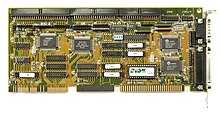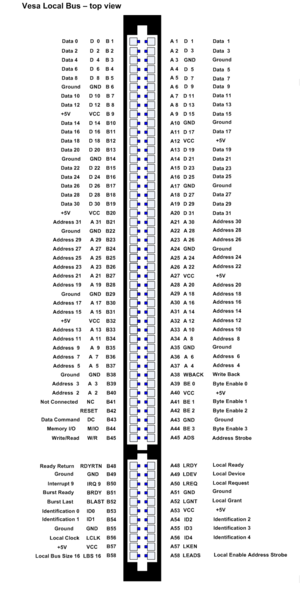VESA local bus
The VESA Local Bus ( VLB ) is a local bus standardized by the Video Electronics Standards Association . It came onto the market in 1992 , experienced its peak from 1993 to 1994 and disappeared again in 1995 . It was used almost exclusively for systems with i486 microprocessors . Since it essentially represents a direct lead out of the i486 signals, it could only be implemented on non-i486 systems with great effort and therefore disappeared soon after the introduction of the Pentium processor.
properties
The bus supplements the ISA bus and enables fast transfers from and to the main memory , also via DMA . The VESA Local Bus was introduced because of the limited data throughput of the ISA bus, which at that time increasingly became a bottleneck for fast graphics cards . In addition to graphics cards, the VLB was often used for hard disk controllers ( IDE and SCSI , partly with integrated floppy disk controllers and / or integrated parallel and / or serial interfaces). Other types of plug-in cards did not require as much data throughput and were therefore still designed as ISA cards for VLB computers.
The term local bus means that it is directly connected to the address and data lines of the processor. It therefore guarantees a 32-bit data transfer. According to VESA specification V2.0, the data transfer has also been expanded to 64 bits through address and data multiplexing . A VLB plug-in card accesses IRQ and I / O lines via the ISA bus, so the VLB is inseparably connected to the ISA bus. VLB slots therefore consist of a normal two-part 16-bit ISA slot (mostly black) and a third slot section with pins that are closer together (often brown), which is connected to the front of the computer. This arrangement means that VLB plug-in cards are inevitably quite long. If necessary, conventional ISA cards can also be used in VLB slots; the third section then simply remains free.
According to the VESA specification, there may only be a maximum of three VLB slots on the motherboard and the clock frequency must not exceed 40 MHz. The clock frequency is derived from the external clock frequency of the processor used. Due to this fact, the use of an i486 processor with 50 MHz external clock frequency is extremely critical, as this can lead to malfunctions in the VLB plug-in cards. Often there is a jumper on the motherboard near the VLB slots with which a wait state (WS) can be set for the VLB cards, which means that they work more slowly, but more stable. Up to a clock frequency of 33 MHz normally no wait state is required (jumper = 0 WS), above this frequency a wait state (jumper = 1 WS) can stabilize the system.
VLB main boards for the Intel Pentium were only produced in small numbers because of the great complexity of the circuitry. There is also the problem that when using a Pentium with 60 MHz or a Pentium-S with 90 MHz, the VL bus has to be operated with the unspecified frequency of 30 MHz. Furthermore, due to the ongoing changes to the VESA definitions, VLB plug-in cards have become partially incompatible with one another. The industry could not rely on the fact that there would be uniform standardization at some point.
Intel decided not to support the VESA bus and instead developed the processor-independent PCI bus and an adapter circuit, the PCI-ISA bridge. The latter enables the use of ISA cards, but not VLB cards, in every PCI system, provided that the manufacturer installs so-called “legacy” slots. The VESA Local Bus was therefore only granted a short period of success.
VIP boards
So-called VIP boards exist from the late days of the VL bus . VIP stands for VL / ISA / PCI. In addition to VL bus and ISA bus, these also have PCI bus slots. This made it possible to use previous ISA and VLB plug-in cards as well as the PCI cards, which were new at the time and therefore less common.
Technical specifications
| Bus width | 32 bit |
| insertable cards | VLB |
| Pins | 112 (plus ISA slot with 98) |
| Operating voltages | +5 V |
| Bus cycle | Depending on the external clock frequency of the processor: 25 MHz, 33 MHz, 40 MHz, 50 MHz (out of specification) |
See also
- ASUS Media Bus - Just as the VLB is an extension of the ISA bus, this bus is an extension of the PCI bus, which, however, has not found widespread use due to proprietary marketing.
- Even before the VLB, the backward-compatible Extended ISA bus (EISA) from Compaq and IBM's radical new development, the Micro Channel Architecture , enabled full use of the 32-bit wide bus of a corresponding microprocessor, but were more likely to be used in high-performance systems for reasons of cost .
Web links
Individual evidence
- ^ Georg Schnurer : Bridge Games . In: c't , 08/1994



